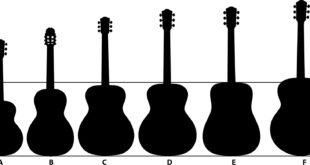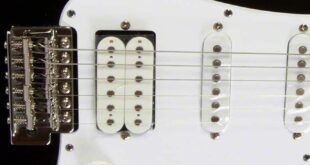Buying your first instrument ought to be the start of a lifelong adventure of discovery and inspiration. It’s also complicated because there are multiple brands and types of musical instruments. We’ve spent a lot of money on gadgets, amps, and more guitars. It’s difficult to comprehend how a small piece of plastic, which costs nearly nothing, can make a significant difference in your playing game. And you probably don’t even realize it. However, the truth is that your pick serves as a link between you and your instrument- it’s like a fingernail extension.
What’s more essential than that? A guitar pick can make everything sound different when you start playing. You might be thinking to yourself: who cares if you’re already at a point in life where you play great without a pick? And we agree with you. However, after a few months or years of practice, you may discover that a simple pick modification can improve, or at the very least affect, you’re playing in an instant.
Guitar picks are sometimes disregarded by guitarists, especially those who are new to the instrument. Guitar picks are so inexpensive that it’s difficult to believe such a small piece of plastic can affect playabilities and tone.
Table of Contents
Our Picks For The Best Guitar Picks
Celluloid is among the first synthetic materials to be utilized to make guitar plectrums for modern guitar pick materials. The Fender Celluloid is a legendary guitar pick with a long history. They essentially created the blues guitar as we know it. This is owing to the employment of this plectrum by blues guitarists. The most popular pick material is celluloid. It has a pleasant, round tone to it. For many professional artists, this is their first choice. There are three gauges available: thin, medium, and heavy. It’s available in a variety of styles and colours to suit your playing requirements.
Pros
- This pick is typically constructed of a hard plastic That has a smaller surface area than your fingers.
- One of the reasons for its popularity is that the sound generated by it is louder and clearer than many other guitar picks.
- When it comes to the heavier gauges, it’s a little stiff.
- Transitioning from one string to the next is not challenging.
- When it comes to the thinner gauges, celluloid is a touch that won’t be too functional for your tastes,
Cons
- It can be perplexing if you mostly utilize the fingerstyle.
Pros
- With the Jim Dunlop Max-Grip Nylon Picks, you can shred without worrying about dropping your pick.
- The moulded gripping surface gives the traction you need to keep your pick in your hand and off the stage floor.
- No matter how sweaty your fingers get, you do not need to worry about these in your hands.
Cons
- Whether it’s due to your brain or simply what you’re used to, picking a note can feel very foreign at times, and you may end up picking the particular wrong chord.
25 celluloid picks in various thicknesses, weights, and colours are included in this value-sized collection. Eight light picks, nine medium picks, and eight heavy choices are also decked in. The thicknesses range from 0.5 to 1.0 millimetres. You can tell which size is which by looking at the three different hues
- Pros
- No matter what your playing style is, the picks are cut in a standard shape for comfy playing and uniform sound.
- The picks are said to be extremely sturdy and gripping, and they glide easily over the strings.
- When it comes to the thinner gauges, celluloid is a touch that won’t be too functional for your tastes,
Cons
- The gleaming jewel-tone colours, according to players, end up making these picks searchable even in the dark.
Pros
- Standard form for comfortable playing
- The D’Addario-branded pick packaging is meant to produce the least amount of waste and have the least environmental effect.
- The picks are said to be extremely sturdy and gripping, and they glide easily over the strings.
Cons
- Pick-style bass players are frequently chastised for not having “real bass playing” or “genuine sound.” While this isn’t true—it doesn’t matter how you play as long as you play—the use of a pick is nevertheless uncommon.
Pros
- Suitable for people of all abilities.
- Works with acoustic and electric guitars, as well as bass guitars with our thicker picks.
- This is the ideal rock music gift for any guitarist or music enthusiast.
- Each package comes with a handy drawstring gift bag.
Cons
- With our handy gift bag, which is tiny enough to take anywhere, keep your picks neat, clean, and all in one spot.
- The deal gift for a guitar player or a fan of music.
Pros
- When you’re not using the picks, the fabric case is attractive and durable for storing them or other equipment such as earphones, tuner, pick holder, strap locks, and so on.
- The colours of every thickness may differ
Cons
- It may have a strong odour when it comes, but it will fade quickly.
The 5 Most Important Characteristics of Guitar Picks
A pick’s accessibility and tone are determined by five factors:
Thickness
Thicknesses Guitar picks are available in one of four gauges:
- .40-.60 mm or less in thickness
- .60-.80 mm is a medium size.
- .80-1.20 mm thick
- Few mm+ Extra Heavy
These ranges can differ significantly depending on the manufacturer. But don’t worry about the specific figures. But why are thick picks preferred over thin picks?
- Brighter tones amplify high frequencies due to their stark surface.
- Because their flexibility limits the loudness you can achieve, and they have a tighter dynamic range, which is ideal for studio recording.
- Acoustic guitar – partially because of the tighter dynamic range and because the particular notes in the chords are more clearly defined.
Why are thin picks preferred over thick picks?
- Mellower Tones — The weight and smoother edges emphasis more bass and less Tripple, resulting in mellower tones.
- Wider Dynamic Range — because they allow for more volume and attack control.
- Because they allow for better speed and accuracy during quick solos, electric lead guitars are preferred.
- Because they provide better clarity and distinction between notes, heavily distorted sounds are preferred
Hardness
Even if a certain selection is a little thin, if it’s made of a different substance, what you’ll discover is that the extra rigidity provides performance similar to that of thicker picks. Likewise, the inverse can be said that thick, yet softer picks have performance characteristics similar to those of most thinner picks.
Texture
The greater textured the pick’s surface, the greater the friction between the pick and the fingers, the better. And, particularly when your hands are sweaty, the quicker it will be to grip. The same could be said about softer picks. And, for the most part, having more grip is beneficial to everyone. However, there COULD (or COULD NOT) be a trade-off because the grain of the pick impacts how it glides off the strings
Rough picks provide more grit and colour to the tone, while smooth, slippery picks produce a smoother, natural tone. Sharp edges offer a greater attack and a brighter sound, while smooth round EDGES have a warmer, purer tone. If you desire a smooth and clean pick, you may have to make up with a more slippery pick.
Shape or Size
Because there is less distance between the hands and the strings when you use smaller picks, it makes diverse hand methods like palm muting and fingerpicking more accessible. Of course, this varies according to the size of the hands. So, the best advice is to get a large enough pick to fit your hands.
If you search hard enough, you may find all kinds of strange pick forms (the most notable case being sharkfin picks). However, in virtually all circumstances, a common version of the conventional triangular teardrop shape is preferable. The sharpness of the impacting surface will determine the variety you choose. Here’s the distinction:
- Sharper points offer a greater attack and a clearer tone, making them ideal for soloing.
- Rounder points give a softer attack and a gentler tone, making them ideal for strumming
Material
The stiffness, texture, and general performance of the pick are all determined by the material used.
These three materials are the most renowned among the various variations:
Nylon — This material is softer and has a textured grip, making it ideal for lighter-weight flexible picks.
Compared to nylon, celluloid is firmer and has a smooth, slicker texture.
Acetal, also known as Delrin (Dupont’s trademarked brand) and Tortex (Dunlop’s popular range), has a grainy grittiness that closely resembles tortoiseshell.
It’s also interesting to note that there are a variety of other, less popular pick materials, such as:
On the hard end, there’s bronze and steel, while on the soft end, there’s wood, felt, leather, and rubber.
Let’s look at why choosing the appropriate guitar pick is important for your guitar growth in this article. We’ve already established that guitar picks are really important in your performance. Choosing the wrong option can hinder your growth and technical ability.
Because of body form and size, height, finger size, hand structure, posture, musical inclinations, and your surrounding environment and home/practice space, this differs from person to person.
There are many fascinating, enjoyable, and gratifying things you may do in music. If you or someone you know is just getting started with guitar, you may feel a little overwhelmed when it comes to selecting the finest beginner guitar gadgets for them. After all, you have many options, from the type of guitar to the style of music you choose to practice.
FAQs
How to Choose the Right Pick Thickness
Starting with Dunlop Tortex selections is the simplest method to discover what’s suitable for you. The thickness of these picks is color-coded. This allows you to compare different textures while maintaining the same material.
What are the reasons guitarists use guitar picks?
Picks are used by guitarists for a variety of reasons. Guitarists use picks (or plectrums) to gain better control over what they play. A guitar pick allows users to perform in ways that they really couldn’t before. A guitar pick allows you to fine-tune your control over the strings you’re playing. Some forms of music are easier to play with fingers (for example, classical), whereas others are easier to play with a pick (for example, jazz and metal).
What is the finest guitar pick for a beginner?
For novices, we recommend grabbing a Dunlop Tortex variety pack. These picks are a good size and have a sticky touch to them. Beginners will find it simple to hold on to and play. The variety set includes picks of various thicknesses, allowing novices to explore and determine what works best for them.
How do guitar picks affect tone?
Guitar picks are important because they affect the tone by changing the way the string vibrates. A stiff and thick pick has a strong attack on the string, which produces more bass and midrange in tone. The material of the pick also plays a vital role in the type of tone you are trying to achieve.
What is the ideal guitar pick size?
The optimum guitar pick size is one with which you are most at ease with. Small gripping picks are preferred by some guitarists, while large picks make it simpler to strum chords without striking your fingers are preferred by others.
Purchase just few various sizes and see what you like to find out what the ideal size guitar pick is really for you. Because every guitarist has distinct pick preferences, you’ll need to experiment with various pick sizes to find the one that works best for you.
FINAL VERDICT
It’s arguably the tiniest piece of guitar equipment on the market. The humble guitar pick, on the other hand, has a greater impact on your skill and sound than you may believe. The guitar pick you choose must be comfortable first and foremost. It won’t perform what you need it to accomplish if it feels correct between the fingers. The purpose of a plectrum is to make whatever instrument you’re trying to play easier to play.
You may already limit down your pick selection based on your chosen tone, performing style, and how correctly you want to play the notes based on everything we’ve discussed thus far. However, this is only a suggestion. It’s all about figuring out what works best for you and having the correct tools on hand. It’s not uncommon to use different options for different situations
 The Occasional Orchestra Learn About Everything Music!
The Occasional Orchestra Learn About Everything Music!









